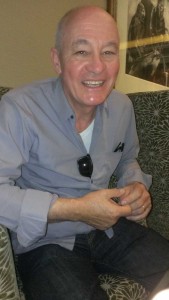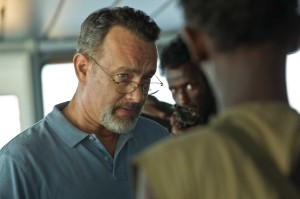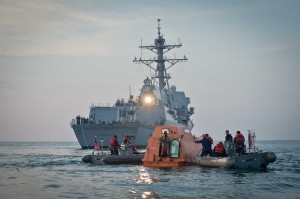
For British director of photography Barry Ackroyd, filming Captain Phillips – based on the true story of the 2009 hijacking of the cargo vessel Maersk Alabama by Somali pirates and the abduction for ransom and eventual rescue of its captain – was as much of a nail-biting adventure as the movie itself. Ackroyd was at times pushed to his physical limits, and often fell back on the concentration skills and gut instincts he learned in his early years shooting documentaries.
The movie, starring Tom Hanks as Phillips and directed by Paul Greengrass, largely takes place on boats in open waters, always a challenging situation for lensing. “It was often arduous and you can see shooting the film as a struggle,” said Ackroyd. “But I’d like viewers to see this as a beautiful film well achieved. How it was achieved is secondary,” he added. “Every film goes through some difficulties. We chose to take them on, not by taking on nature, you can’t do that. But we trusted nature as we found ourselves at sea, whatever the weather.”
Filming started in Morocco for scenes of the Somali pirates launching out from the beach to start the attack. The shoot then shifted to the Mediterranean several miles off Malta. There events on the container vessel were filmed where it appears to be on the wide open ocean and is approached by the marauders speeding on small skiffs. They then daringly clamber aboard and take over the ship. The conditions were precarious for both the actors and for Ackroyd operating the camera from within one of the water-tossed skiffs.

He shot on film using French Aaton cameras, favored by many documentary makers, on 16 mm and also 35mm. The 16mm handheld was much more maneuverable. “You’re inside the lifeboat or the skiff with the pirates, and the 35mm version would be an 11 kilo lump. You can’t bounce that around at sea,” he observed. The 16mm was equipped with the same range of lens, but was much lighter. No stabilizers were used for shooting, only a scaffold rig with a rubber bungee was attached so as not to lose the camera over the side of ship.
The next move was to the waters six-10 miles off Virginia Beach on the East Coast, where there’s a large U.S. naval base. The Navy cooperated, supplying a destroyer and other ships for the climactic nighttime rescue of Phillips from his captors by Navy Seals (they weren’t actors, but the real deal). “We had three navy ships – a frigate, a destroyer and an aircraft destroyer, plus the lifeboat in the sea, helicopters in the sky with one helicopter photographing the helicopter over the sea shining a light on the lifeboat,” the cinematographer explained.
One camera was inside the lifeboat, the DP was operating another camera from a rubber-hulled inflatable boat, a third camera was on the destroyer, and a fourth was an aerial camera shooting from the helicopter. “All of that was done dusk-for-night, and dusk is only 20 minutes,” he noted. “You have 20 minutes to capture a maximum of material. And you can’t stop, or dusk will change and all of a sudden you are shooting night-for-night,” he added. But the cameras had to keep rolling in what was then close to total darkness. No CG was used to enhance the live shooting. “People would always ask, ‘How are we going to do it?’ Well, we’re going to shoot it. That’s what I live for.”
 CG was only used to make the scene where the water pouring out in torrents from the ship’s hoses appear more substantial. “If we filmed what they actually did, we would have looked really foolish,” said Ackroyd. CG was also to create some highlights on the ocean.
CG was only used to make the scene where the water pouring out in torrents from the ship’s hoses appear more substantial. “If we filmed what they actually did, we would have looked really foolish,” said Ackroyd. CG was also to create some highlights on the ocean.
Apart from the tumultuous scenes at sea, the film reaches a cathartic emotional climax at the very end when Phillips has been rescued and is safe, then breaks down and lets it all out after having restrained himself by being pragmatic throughout the crisis. With Hanks in the scene is only a nurse, played by a non-professional actor, who improvises her lines as she tries to soothe him. “Tom was amazing as was the medic, and we did it in only two takes,” said Ackroyd. “Tom is so familiar with filmmaking that even when the camera is very close, he doesn’t notice it. It’s there but it’s not, and it doesn’t stop him from thinking and acting brilliantly as in those final moments, where it would be very hard not to be moved.”
Ackroyd received an Oscar nomination for best cinematography for his work on Hurt Locker, directed by Kathryn Bigelow, about the tense task of an American bomb squad in Iraq. He has collaborated with Greengrass before on Flight 93 and Green Mile. He has also worked repeatedly with English neo-realistic director Ken Loach, most notably on The Wind That Shook the Barley.
Before that he shot numerous documentaries and that experience has informed his work on features. “Everything is related to that,” he said. “If I’m stuck for a lighting situation, or trying to visualize people pushing fishing boats out to sea, I literally have a rolodex of shots from 50 countries to refer to. The thrill is to keep a feature looking somewhat like a documentary where every frame is precious and every take could be in the film. That’s all I’m thinking about when I’m shooting. Your muscles may feel strained or you are physically in the wrong place, but the lens is in the right place.”





